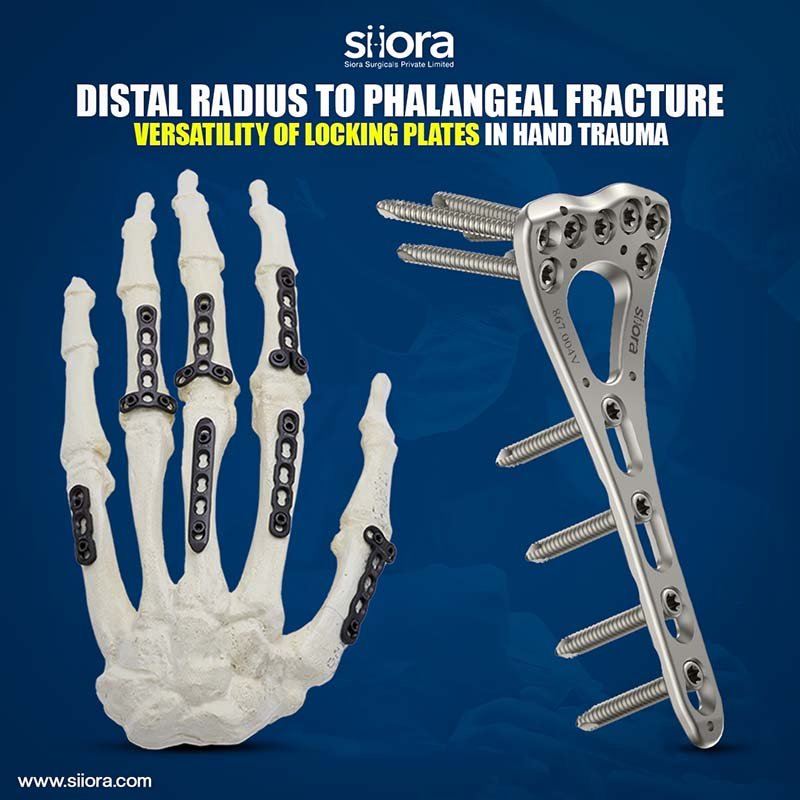Hand fractures can be debilitating, affecting everyday tasks like writing, gripping objects, and even personal care. The right treatment is crucial for a quick recovery and optimal functionality. In recent years, advancements in orthopedic technology have introduced innovative solutions, with the Microlock Locking System by Siora Surgicals Pvt. Ltd. standing out as a superior option compared to traditional hand fracture fixation methods. But how do these two approaches compare? Let’s delve into the differences and determine which offers better outcomes for patients.
Understanding Traditional Hand Fracture Fixation
Traditional hand fracture fixation has been the gold standard for decades. Surgeons use conventional methods such as K-wires, screws, and plates in hand fracture to stabilize it.. The primary goal of these techniques is to realign the fractured bones and allow natural healing over time.
Key Features of Traditional Fixation Methods
K-Wires and Screws
Kirschner wires (K-wires) are often used for temporary fixation, but they require external stabilization and are prone to complications like infection or loosening. Screws, on the other hand, provide better internal fixation but may not always offer sufficient stability for complex fractures.
Standard Hand Plates
A hand plate is commonly used for stable fixation. However, traditional plates are not designed with locking mechanisms, making them susceptible to screw loosening and inadequate compression at the fracture site.
Healing and Complications
Traditional methods often require immobilization for extended periods, leading to stiffness and prolonged recovery times. Additionally, screw back-out and implant failure can compromise the healing process.
Microlock Locking System – The Game Changer
The Microlock Locking System represents a significant advancement in fracture fixation technology. Designed with precision engineering, this innovative system offers enhanced stability, better anatomical conformity, and improved patient outcomes.
Why the Microlock Locking System Is Better?
Locking Hand Plate Technology
Unlike traditional plates, the Microlock system features a locking hand plate that securely engages with screws. This prevents loosening and provides a more rigid construct, ensuring optimal fracture stability.
Improved Bone Healing
The system distributes force evenly across the fracture site, reducing micro-movements that can delay healing. This leads to faster bone regeneration and lowers the risk of complications.
Anatomically Contoured Design
The Microlock Locking System is engineered to match the natural shape of the hand and radius. Whether a surgeon is using a hand bone plate or a radius fracture plate, the contoured design minimizes soft tissue irritation and enhances patient comfort post-surgery.
Reduced Need for Post-Operative Immobilization
Unlike traditional methods that often require prolonged casting, the superior stability of the Microlock system allows for early mobilization, leading to better functional outcomes and quicker return to daily activities.
Head-to-Head Comparison: Traditional Fixation vs. Microlock Locking System
| Feature | Traditional Fixation Method | Microlock Locking System |
| Stability | Moderate stability; there is a slight risk of loosening. | High stability due to locking mechanism. |
| Bone Healing | Slower healing with a high risk of malunion. | Faster bone healing with even force distribution. |
| Surgical Precision | Standard plate design. | Anatomically contoured plates. |
| Post-Operative Care | Requires longer immobilization. | Allows early mobilization. |
| Complication Risk | Higher risk of screw back-out. | Locking features reduces the risk of screw loosening. |
| Patient Comfort | May cause soft tissue irritation. | Better patient comfort. |
Why Surgeons Prefer the Microlock Locking System?
The benefits of the Microlock Locking System make it the preferred choice among orthopedic surgeons. The combination of a locking plate for hand fracture and optimized screw engagement provides unmatched stability. Additionally, the versatility of Microlock plates, including radius plate and hand fracture plates, ensures that surgeons can address a wide range of fracture patterns with precision.
Another advantage is its ability to support early motion. Traditional fixation methods often require extensive immobilization, leading to stiffness and decreased range of motion. With the Microlock system, patients can begin rehabilitation sooner, enhancing long-term hand function.
Patient Outcomes: Traditional Fixation vs. Microlock Locking System
Patients treated with the Microlock Hand Plating System report better recovery experiences. Studies have shown that individuals who receive locking hand plates experience:
- Shorter recovery times
- Fewer post-surgical complications
- Improved grip strength and dexterity
- Enhanced bone healing with minimal risk of nonunion
On the other hand, those who undergo traditional fixation often face challenges such as implant failure, longer healing periods, and delayed functional recovery.
The Future of Hand Fracture Fixation
With continuous advancements in medical technology, the Microlock System is setting new standards for hand fracture treatment. Its ability to provide superior stability, enhanced healing, and improved patient comfort makes it the future of hand surgery.
While traditional fixation methods have served their purpose, the evolution of locking hand plates and hand locking systems like Microlock ensures that patients receive the best possible care with fewer risks and faster recovery.
Conclusion
When comparing traditional hand fracture fixation to the Microlock Locking System, it’s clear that Microlock offers superior advantages. The inclusion of locking hand plates, anatomic design, and enhanced stability make it the preferred choice for both surgeons and patients. As medical technology continues to evolve, the shift toward advanced locking hand systems will further improve surgical outcomes and patient satisfaction.For anyone facing a hand fracture, discussing the benefits of the Microlock Locking Hand System with a healthcare provider can be a game-changer in achieving the best recovery possible.






